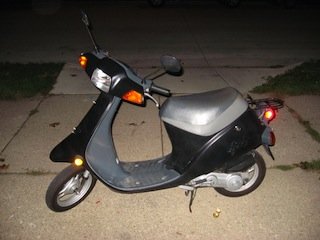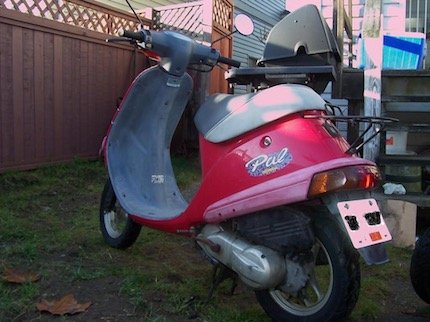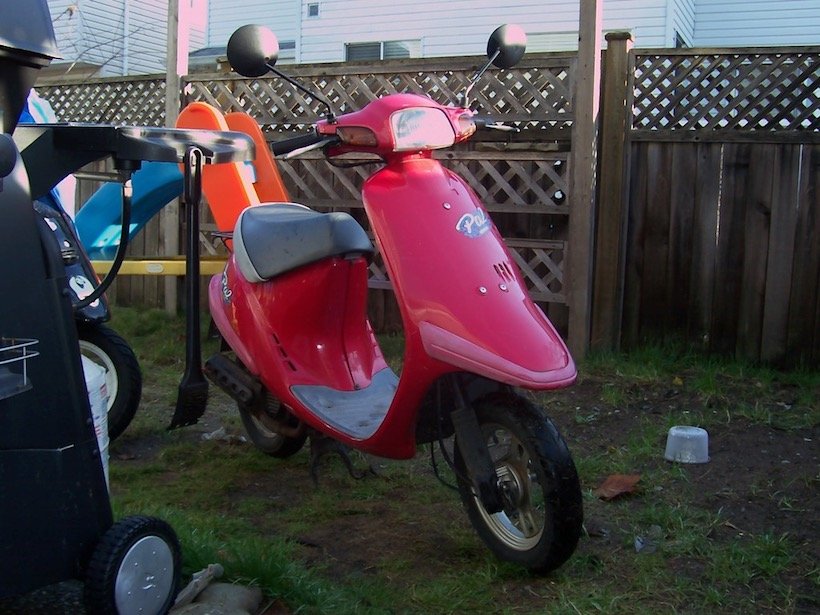HONDA ELITE E / ES / PAL (SB50)
Honda introduced the SB50 in 1988 as a replacement for the fairly popular Spree (NQ50). This scooter bares a stylistic resemblance to the physically larger Elite SR / LX (SA50) scooter which was also introduced for 1988 but in reality, these scooters are almost 100% different. The body panels are not compatible as the SB50 is a much smaller machine. The motor, frame, suspension etc are all entirely different. The SB50 was a cross between Honda’s Spree engine and a mini version of the Elite SR / LX (SA50) style.
The Elite E / ES was offered by Honda in the USA and Canada for three years. 1990 was the final year for this small scooter, leaving the larger Elite SR / LX to woo customers in American showrooms. The situation was more dire in Canada, where just the Elite S / R (SE50) was offered until the Dio was introduced for 1992.
Versions
This scooter was sold under the ‘Elite ES’ name in the USA and the Pal name in Canada. Honda also a restricted version (model code SB50P) called the ‘Elite E’ (30mph) which met moped licensing laws in most states. Honda seems to have also sold a restricted version in Canada but they used the Pal name for both versions which made things confusing for owners. In total, there was five versions sold:
- Elite ES (SB50) – Unrestricted SB50 sold in USA, single speed transmission, 35mph
- Elite E (SB50P) – Restricted SB50P sold in USA, single speed transmission, 30mph
- Pal (SB50) – Unrestricted SB50 sold in Canada, CVT transmission, 35mph
- Pal (SB50P) – Restricted SB50P sold in Canada, single speed transmission, 30mph

Motor
The motor used in the SB50 is the same basic motor as the one used in Honda’s Spree scooter (NQ50), so you can use parts from that engine. However, there are several small but important differences. One notable difference is that the SB50 uses as improved intake and larger reeds, so installing a Spree intake would reduce your performance. Other differences include the drive pulley design and bearing size used in the transmission. Review the Spree page for a little more detail on the engine differences. Aftermarket performance parts for this engine are limited, but some are available.
Design
The SB50 was designed to be a low cost scooter, which means there’s drum brakes at both ends. There’s also no glovebox or even a cubby hole in the legshield for quick storage. Thankfully Honda did include a moderately sized underseat storage space which will be able to swallow common items like rain gear or a half helmet.

Discussion
Buyers for the Elite E / ES scooter were few, making it quite a rare scooter in North America and even quite uncommon overseas under the Pal badge. Most likely, the Pal was simply physically too small for most North American riders. For an extra $100, you could buy a larger, nice and much faster Elite LX (SA50), so the Elite E/ES only appealed to people who needed a moped compliant ride, lived in a state where the Elite LX wasn’t moped compliant (rules vary) and were physically small enough to ride the Elite E / ES.
On the plus side, this small/light scooter is easier to tuck onto the back of an RV and it does have good underseat storage unlike the larger Elite LX / SR.
Pros:
- Unique
- Lightweight
- Good underseat storage
- Excellent reliability
Cons:
- Slow
- Fits only smaller riders
- Difficult to modify for more speed
- No glovebox / front storage area
Links:
Official SB50 Service Manual – Great info gathered by the fine folks at HondaSpree.net
MotorscooterGuide Forums – Visit the forum on this site to chat about your scoot.
HondaSpree.net – Great Forum for the Aero, Elite and Spree scooters.
ScooterSwapShop – Aftermarket goodies
Colors:
- 1988: Fighting Red, Sherbet Pink (Elite E) and Black, Foam Green (Elite ES)
- 1989: Black, Sherbet Pink (Elite E)
- 1990: Black, Sherbet Pink (Elite E)
Key Specs:
- Engine: Air-cooled, 2-stroke single, 49cc
- Compression Ratio: 6.8:1 (SB50), 7.0:1 (SB50P)
- Bore x Stroke: 41.0mm x 37.4mm
- Starter: Electric and Kick
- Transmission: Single Speed V-belt with automatic clutch
- Length: 60.8″ / 1545mm
- Width: 25.6” / 650mm
- Height: 39.4” / 1000mm
- Wheelbase: 42.9” / 1090mm
- Fuel Capacity: 3.8 L / 1.0 US Gallons
- Tires: 2.50 x 10” (Front & Rear)
- Front Suspension: Telescopic, 56mm (2.2″) travel
- Rear Suspension: Swing unit, single shock, 59mm (2.3″) travel
- Brakes: Drum / Drum
- Dry Weight: 108 lbs / 49 kg
- Engine Weight: 32.41 lbs (dry)
- Max Weight Capacity: 180 lbs / 82 kg
- Final Reduction Ratio: 6.385:1


